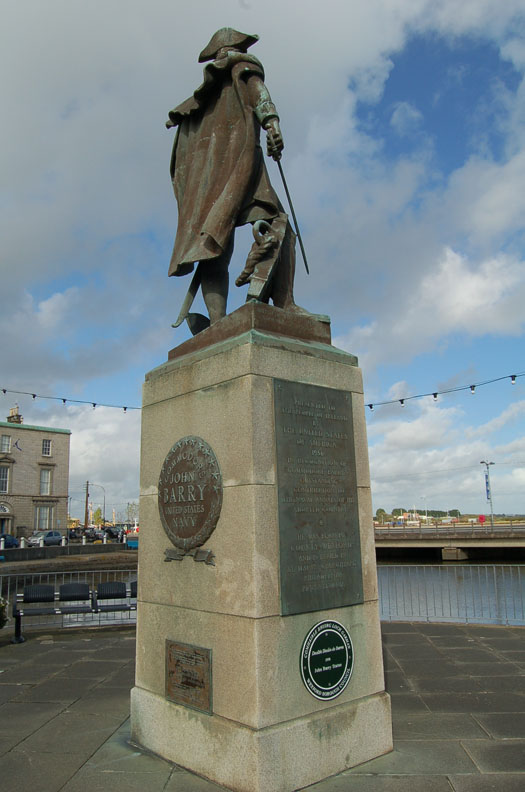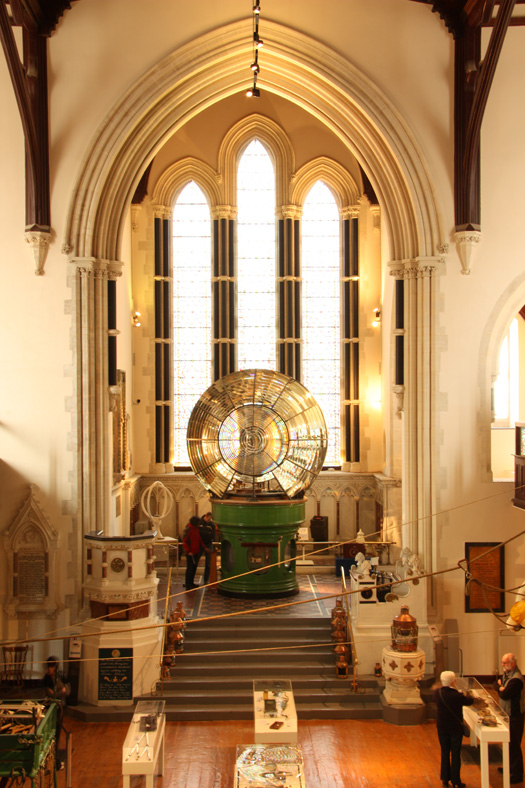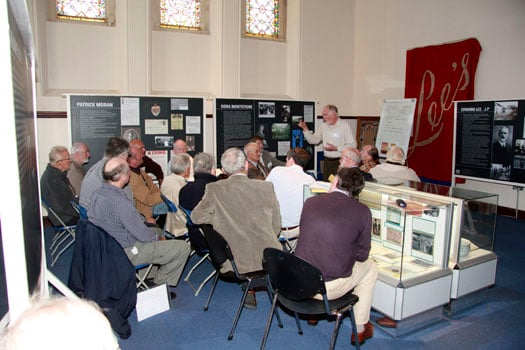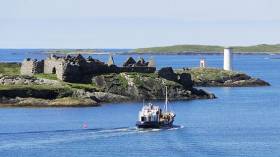Displaying items by tag: Grace O'Malley
The Atlantic Youth Trust Tall Ship Grace O'Malley is now back in Belfast. The charity says will move to the Harland & Wolff shipyard for detailed scoping-out to repurpose the ship that arrived in Ireland this summer.
As reported in numerous articles in Afloat.ie for many months now, having been bought in Sweden the 164ft (153ft hull length) three-master has been gradually introducing herself to all of Ireland.
Belfast concludes the round Ireland 2022 tour of the ship, which generated significant public interest. Over 5.000 visitors and youth groups went on board the ship at different harbours, beginning at the Foyle Festival on July 26th, debuting in Dublin on August 18th and Cork Harbour on the 26th.
Rather than rush into any work on the boat at this point, Enda O'Coineen, of the charity, says at this stage "all options are being explored with detailed scoping, costing and planning as our development team explore long term plans and essential core funding etc"
Tall Ship Grace O'Malley Arrives in Cork Harbour
Tall ship Grace O'Malley arriving in Cork Harbour this evening for a weekend visit to Leeside to show herself to the public.
The 164-ft ship is due to be in the city until Tuesday.
As reported in numerous articles in Afloat.ie for many months now, having been bought in Sweden the 164ft (153ft hull length) three-master has been gradually introducing herself to all of Ireland, via the Foyle Maritime Festival, followed by time in Belfast, and then Warrenpoint before coming on south this week under the command of Capt. Gerry Burns to Dublin, where she was berthed at Sir John Rogerson's Quay.
It will be 2023 before the ship has been fully re-configured to accommodate a throughput of a thousand trainees annually. Their learning experiences can be adapted to include much more than traditional sail training in a committed acknowledgement by the AYT that nowadays, tall ships have to be multi-purpose in order to earn their keep.
More on the Grace O'Malley and her tour here
Tall Ship Grace O'Malley Makes Peaceful Debut In Dublin
When we remember that as recently as 1576, the most memorable visit to the Dublin area by the Connacht Pirate Queen Grace O'Malley resulted in her kidnapping of the heir to Howth Castle in a dispute about the hospitality - or lack of it - extended to the O'Malley crew, then perhaps we should be grateful that - so far - the only capturing caused by the arrival in Dublin Port for the first time of the Tall Ship Grace O'Malley has been of the hearts and minds of maritime-minded folk, who hope to see this new Atlantic Youth Trust initiative continue to develop towards complete success.
As reported in numerous articles in Afloat.ie for many months now, having been bought in Sweden the 164ft (153ft hull length) three-master has been gradually introducing herself to all of Ireland, via the Foyle Maritime Festival, followed by time in Belfast, and then Warrenpoint last weekend before coming on south this week under the command of Capt. Gerry Burns to Dublin, where she has berthed at Sir John Rogerson's Quay.
It will be 2023 before the ship has been fully re-configured to accommodate a throughput of a thousand trainees annually. Their learning experiences can be adapted to include much more than traditional sail training in a committed acknowledgement by the AYT that nowadays, tall ships have to be multi-purpose in order to earn their keep.
Tall Ship Grace O'Malley Catches The Eye in Belfast
The Grace O’Malley was a massive attraction in Derry last month at the Maritime Festival, said the Captain, Gerry Burns, whose home is in Newcastle Co. Down
The 164-ft tall ship is destined to serve Ireland as a training vessel for young people as part of the Atlantic Youth Trust, whose mission is to “Connect Young People with the Ocean and Adventure.”
The aim is for it to replace the Asgard II (ROI based) and the Lord Rank (NI based).
The ship, which was built in Sweden, is operating under the Swedish flag and her original name, The Lady Ellen.
After the Derry visit, Grace O’Malley came to Belfast and lay in the River Lagan alongside the Maritime Mile beside the SSE Arena where she caught the eye of the many people who walk along the quay. After moving to Belfast Harbour Marina close by, she played host to several dignitaries and stakeholders, including the Lord Mayor Councillor Tina Black.
 Grace O'Malley lay in the River Lagan in Belfast alongside the Maritime Mile beside the SSE Arena
Grace O'Malley lay in the River Lagan in Belfast alongside the Maritime Mile beside the SSE Arena
By Friday, she will be in the port of Warrenpoint at the head of Carlingford Lough. The crew will have stunning views of the Mourne Mountains before she reaches Carlingford Lough where she will stay till Wednesday 17th, after which Dublin is the next stopover, and then Cork.
The Atlantic Youth Trust is the brainchild of businessman Enda O’Coineen from Galway, well known in sailing circles and yacht racing circles, and the Grace O’Malley replaces the Asgard, the Irish national training ship and the UK equivalent, the Lord Rank, both sadly sunk several years ago.
This vessel has a crew of 12 (one of which is Brian O’Malley, a direct descendant of Grainne Ni Mhaille) and can take up to 25 trainees. Intrinsic in the vision is the role of volunteers and one such who had answered the call was Simon from Ballyholme Yacht Club - he was relishing the thought of the passage to the next stop at Warrenpoint.
Captain Burns is enthusiastic about the Grace O’Malley. “Our mission is to introduce the ship to as many people in Ireland as possible”.
Tonight RTE Nationwide will broadcast a feature on a planned new sail training tall ship for Ireland.
As Afloat first reported last October, the new ship is intended to replace the lost Asgard II.
The 17-minute piece by Donal Byrne documents the first test sail by the Irish group in Sweden.
The Atlantic Youth Trust Charity chaired by Round the World sailor Enda O'Coineen, says the 164ft Tradewind schooner it has identified will act as the new ‘flagship’ for introducing young people across the island of Ireland to maritime and careers.
The ship is to be renamed the Grace O’Malley, after the so-called Mayo ‘Pirate Queen’. Built of steel in a modern structure, and elegant lines of a 19th century Tall Ship, she is considered fit for purpose to high safety specifications.
There is a plan to acquire a new ship to replace the Asgard - Donal Byrne went to Sweden with the Irish group behind the project to test sail a ship for the first time - See #RTENationwide on Monday 14th March @RTEOne 7pm @atlanticyt @AfloatMagazine @SailTrainingIre @EOCoineen RT pic.twitter.com/5wXE53liIR
— RTÉ Nationwide (@RTENationwide) March 13, 2022
In addition, the Charity says the tall ship will have a key role to play in the areas of research, innovation, tourism promotion and providing a support outlet for vulnerable young people.
The charity is seeking funding from the British and Irish governments to finalise the purchase of the vessel.
Nationwide is broadcast tonight at 1900 hrs (Monday, 14th March).
Also read: WM Nixon's Ireland’s Hopes for a Tall Ship Are Running High
Tall Ship Youth Training Vessel Requires Urgent Reinstatement of State Funding - Atlantic Youth Trust
Youth development, education and cultural charity the Atlantic Youth Trust have made a direct appeal to An Taoiseach, Micheál Martin TD and Minister Simon Harris TD, to reinstate the €950,000 which came from the National Lottery to support the operational costs of a new tall ship for Ireland. The charity made the call against the clear commitment in the Programme for Government to develop Ireland’s ocean wealth, sustainability, and the environment.
As Afloat reported earlier, the group says it has identified a ship to replace the lost Asgard II. The ship, the trust says, will act as the new ‘flagship’ for introducing young people across the island of Ireland to maritime and careers. In addition, it will have a key role to play in the areas of research, innovation, tourism promotion and providing a support outlet for vulnerable young people.
 Chair of the Atlantic Youth Trust, Enda O'Coineen
Chair of the Atlantic Youth Trust, Enda O'Coineen
Chair of the Atlantic Youth Trust, and former Director of Coiste an Asgard, Enda O’Coineen was introduced to the ocean and adventure on the original Asgard. He advocates for how this opportunity changed the course of his life and is joined by a high-level group of youth workers, people in business and academics behind the project. Commenting Mr O’Coineen said: “With a large research-led support base, we have long since championed for the need to replace Ireland’s lost sail training vessel the Asgard II in a dynamic and creative new way.
“This would be a strategically important move for ensuring we are well-positioned to maintain our island’s rich maritime heritage, skill set and knowledge. This will be vital for connecting future generations with the ocean and adventure who might normally never get the opportunity. As we emerge from the Covid 19 pandemic, the urgency for supporting projects like this has never been more important as we seek to address growing mental health challenges facing our young people.”
In looking for a solution to this, the Atlantic Youth Trust has identified, a 164ft Tradewind schooner lying in Sweden which is an ideally suited replacement for delivering youth maritime development and sail training.
 The 164ft Tradewind schooner lying in Sweden
The 164ft Tradewind schooner lying in Sweden
The ship is to be renamed the Grace O’Malley, after the so-called Mayo ‘Pirate Queen’. Built of steel in a modern structure, and elegant lines of a 19th century Tall Ship, she is considered fit for purpose to high safety specifications.
Mr O’Coineen added: “In our recent pre-budget 2022 submission to the Office of An Taoiseach and other Government Departments, we called for the reinstatement of an annual Government subsidy to assist with the day-to-day operational costs of a new vessel.
This funding was previously channelled through the National Lottery. Given the strong training and education remit planned for the new vessel, we believe it’s pertinent that Government funding, if reinstated, is directed via the Department of Further and Higher Education, Research, Innovation and Science, under Minister Simon Harris.
“To support our pre-budget submission, we also included a comprehensive business proposal outlining how the purchase of the identified successor ship will be funded through private and philanthropic sources. This can only happen if the State commits to reinstating the former Asgard II National Lottery funds to support the new ship’s operations budget. We believe the reinstation of these funds would go a long way in supporting a clear commitment made in both the Programme for Government and the Ocean Wealth Strategy to develop Ireland’s ocean wealth, sustainability, and the environment, integrated through the National Marine Co-Ordination Group”
In addition, the Atlantic Youth Trust are seeking a once-off commencement grant from Government of €880,000 to support refit costs, ensuring the ship is fit-for purpose with disabled access as well as the establishment of an organisation to run the ships operation. This commencement budget would represent approximately 20 per cent of the insurance funds retained by the State when the Asgard II was lost.
Head of the National Maritime College of Ireland and Atlantic Youth Trust advisory board member, Cormac Gebruer said: “To have a tall ship back in Ireland repurposed to introduce our younger generations to the maritime would be a significantly important and strategic development for the College. There are huge opportunities to utilise this initiative for research purposes linking in with human behaviour and marine sciences which would complement the work we are doing here in the College.
“The Atlantic Youth Trust has been an exemplary resource in leading a world-class solution for youth development integrated with the maritime across Ireland together with its focus on research and partnering with other colleges, such as NUI Galway. We at the National Maritime College of Ireland very much support the endeavours to secure a suitable replacement tall ship training vessel following the loss of the Asgard II.”
As Afloat reported at the time Asgard sank off the French coast in 2008. More details on the background to the sinking, campaign to raise and then replace her are in Afloat's dedicated Asgard II section
Co-founder of Sailing into Wellness and Atlantic Youth Trust advisory board member, James Lyons said: “Following a recent visit to Sweden to see the proposed successor ship in lying, I’m convinced that she will fire people’s imagination if brought to Ireland renamed as the Grace O’Malley. Built with submarine steel to the highest specifications and modelled on a classic wooden tall ship, she will make an ideal tall ship for Ireland with some small modifications.”
Once the Irish Government commits to the reinstatement of the Asgard II funding, additional financial support for the project will then be sought from the Northern Ireland Executive, with the initiative marked as a North-South venture. It’s envisaged that the ship will act as a fantastic promotional platform for tourism, enterprise, culture and the marine across the island of Ireland.
Chair of Tall Ships Belfast 2009 & 2015 and Atlantic Youth Trust advisory board member, Dr Gerard O’Hare said: “While there is an onus on the Irish Government to honour its commitment to supporting the maritime through the reinstatement of the Asgard II funding, there is also scope to seek support from the Northern Irish Executive once the project is up and running. This could include part-funding the initial fit-out planned for early 2022 in Belfast.”
'Pirate Queen' Castle Relic Found On Inishbofin
#Inishbofin - Archaeologists say a decorated stone found recently on Inishbofin was once part of a 'lost' castle stronghold of Connemara's 'pirate queen' Grace O'Malley, as The Irish Times reports.
References to two castles held by the O'Malley clan on the island off Connemara in the Middle Ages -- part of a string of fortifications along the coast -- have been confirmed only by minor traces, such as a window fragment at Dún Gráinne.
But the doorway stone recently identified within the 100-year-old boundary wall of Daly's pub is said to be the strongest evidence yet of a castle last recorded on 19th-century maps of the island.
The Irish Times has more on the story HERE.
Is Ireland's Maritime Heritage Recognised?
#maritime – I was giving a talk at Bishopstown Library on the western side of Cork City during Heritage Week on the subject – "Is Ireland's Maritime Heritage Recognised as Part of Ireland's Heritage?" – outlining what had been achieved by some of the many great Irish maritime figures when a member of the audience asked: "Why is it that we have heard so little about them?"
Thereby hangs a tale.
Is it neglect, ignorance or a failure of our educational system that Irish public consciousness appears to lack awareness of the impact which Irish mariners have made on world and Irish history?
From St. Brendan the Navigator; Grace O'Malley, Granuaile; John Philip Holland; Tom Crean; Captain Robert Halpin; Ernest Shackleton, all Irish, to Admiral Barry of Wexford; Admiral William Brown of Foxford; Francis McClintock; Captain Roberts of the Sirius, the first steamship to cross the Atlantic; Jerome Collins, the first media meteorologist; all are names which, when brought together underline a strong maritime heritage and there are more.
In fact, there are records of Irish seafarers having been involved in fighting the Roman Empire; of Irish ships developing foreign trade in the Middle Ages. Irishmen have explored the Artic regions, developed the submarine and the marine turbine engine and formed navies in several parts of the world.
"I never knew about those people, this has opened a window of knowledge, why do we not take pride in our marine heritage?" one woman asked me after the talk, while another man said: "It makes me proud to know what our mariners have achieved, but it is not common knowledge"
There are people who are trying to remedy the years of neglect of our maritime heritage and one effort in this regard is the symposium which the National Maritime Museum in Dun Laoghaire will hold later this month. This is being organised jointly with University College Dublin and is a response to the "extremely low level of Irish maritime heritage research."
That lack of research was identified in the Maritime Heritage Gathering Report last year which made a key recommendation that it should be rectified.
Professor John Brannigan, Senior Lecturer in UCD's School of English, Drama and Film, got in touch with the Maritime Museum to find out how students at UCD might be able to use the Museum's library and artefacts to deepen their understanding of Irish maritime history and culture.
That followed the development of a relationship between the Museum and the College which had started with six Library and Information Studies' students assisting Museum volunteers to re-instate the Museum's extensive Library and Archive.

Admiral John Barry Statue - The Irishman Who Founded The Us Navy - Watches Ovr Wexford Harbour
UCD's Earth Institute, UCD's Humanities Institute and the Atlantic Archipelagos Research Consortium have agreed to sponsor an Irish Sea symposium in the Museum. To organise it, Professor Brannigan teamed up with Dr.Tasman Crowe from UCD's School of Biology & Environmental Science and Richard McCormick, the Museum's Director of Library and Archive.
Richard is a former staffer with Bord Iascaigh Mhara, the semi-State fisheries board, who has been carrying out extensive work on re-instating the library and archive at the National Museum house in the Mariners' Church at Dun Laoghaire, following the extensive renovations there. It has a collection of 5,000 books and archival material collected in over 73 years and which has been in storage for 7 years due to the extensive renovations to the Mariners Church.

Inside National Maritime Museum
"The Maritime Museum is a rather impressive 177-year old church building in which the Royal Navy and seamen and fishermen passing through Dun Laoghaire worshipped and we also have the original RN prisoners docks," Richard McCormick told me. "I am very pleased with our association with UCD as if the National Maritime Museum is to prosper it has to broaden its appeal and let people know we exist and this symposium will help by reaching an international audience through UCD's Scholarcast system (http://www.ucd.ie/scholarcast/series7.html) which gets 2,000 hits a month"

Maritime Heritage Gathering In The National Museum Last Year
"This symposium and the Maritime Heritage Gathering last year are small but significant steps in raising the profile of Ireland's rich maritime heritage. This will not only be good for us, but also for all the Irish maritime museums around the coast and justify the sterling work that is being done in this field by the voluntary sector."
Quite a lot of local maritime museums and independent researchers attended the Maritime Heritage Gathering last year from all around the Irish coast and from the UK. Museums and heritage researchers can often find themselves working in isolation on maritime heritage and, perhaps consequently, this work does not get the official attention that it deserves.
"The serious recommendations that arose from that event will simply have to gain momentum and traction in the years to come," says Mr.McCormick.
"Our Museum Library & Archive forms a very important component of our maritime heritage. The merchant marine and leisure sectors are very well represented, so is the Royal Navy from historical times and I am very keen in the coming years to acquire documentary, photographic and audio visual material about the fishing industry so that its story can also be recorded for posterity."
At the symposium, twelve speakers will cover topics as diverse as the Irish Sea's underwater heritage, its fisheries, marine biology, coastline and seabed mapping, in addition to its rich maritime art, history, poetry and literature as well as the prolific smuggling industry that once thrived in North County Dublin. This mix of interests is designed to stimulate debate about the Irish Sea and will conclude with workshop sessions to ascertain how the various constituencies might collaborate together in a large interdisciplinary research project. The speakers' presentations will also be recorded for a worldwide audience on UCD's Scholarcast Series and, should this event prove successful, consideration will be given to expanding the geographical range in future years.
The symposium will begin with a free public lecture in the Maritime Museum on 'The Nature of the Irish Sea Coast' on Friday September 19 at 7 pm by Richard Nairn, with the Museum being open to the public prior to that as part of Dun Laoghaire Rathdown County Council's Cultural Night celebrations. Entry to the Symposium on Saturday, September 20, will cost €10 for the day, payable on registration at the Museum. There will also be an optional €30 dinner for participants in the National Yacht Club, Dun Laoghaire on Saturday night, also payable at registration.
For information on the symposium and to register for the event visit here. More than half the available places have already been booked.
• You can view the interior of the national Museum by clicking here
• To read the report of last year's Maritime Heritage Gathering click here
Email: [email protected]
Twitter: @Tom MacSweeney @AfloatMagazine






























































